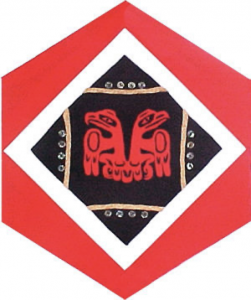Haida

The Block
The central theme in this block is the symbol of the Council of the Haida Nation, executed by Gladys Jiixa Vandal, of the Haida Eagle clan, in the form of two-dimensional work known as “flat design.” The Eagle and the Raven, which represent the two main social groups or “moieties” of the Haida, are appliquéd to the black backing fabric. Surrounded by traditional, plaited-cedar-bark weaving and abalone-shell buttons, the design respects the formal canons of both line and form typical of Northwest Coast native art.
Cultural Profile
The Haida, whose name means “people” in their own language, Nadene, now mostly live on Graham Island, part of the archipelago located on the northern coast of British Columbia known as the Queen Charlotte Islands. In 1787, Captain George Dixon named the islands after his ship and his Queen. The Haida call their territory Haida Gwai, which means “islands of the people.” The Haida people were socially organized within two moieties, the Eagle and the Raven, each subdivided further into clans.
Skilled boat-builders and master wood carvers, their style of artistry is recognized the world over. Their homes were built of red cedar wood, with roofs sloping down at an angle from the centre. The family crest was displayed on a carved totem pole in front of the house. The raising of a totem pole was cause for celebration with a potlatch ceremony. Potlatches also marked major life events, such as the giving of names, marriage and death. Often it took years to acquire enough food and wealth to hold a potlatch celebration with its requisite distribution of gifts.
Cedar bark weaving is another traditional art of the Haida. Using the technique of plaiting and twining, contemporary weavers create a variety of traditional and modern forms, using red and yellow cedar bark and spruce roots. The cedar bark is harvested from May to July. The trees are not damaged when the harvester removes only what is necessary. In Haida culture it is customary to thank the Creator before harvesting the bark.
In order to access resources only available on the mainland the Haida would trade beautifully handcrafted and carved products such as canoes storage chests and other household items. They imported copper and silver and made engraved copper shields, and jewellery, then traded these articles to tribes on the mainland. When European traders and American traders arrived on the west coast, the Haida specifically tailored their production of art to attract their attention. Small carvings made of argillite (a soft black stone) were especially popular among the white traders.
The South Moresby group of the Queen Charlotte Islands has been designated a National Historic Site. Within the area are three ancient Haida villages, Skedans, Tanu, and Skungwai, the last of which is also a UNESCO World Heritage Site. A committee called the Haida Gwaii Watchmen, made up of members of the Haida community preserve their cultural heritage by monitoring public access to national historic sites throughout the islands. From its headquarters in Skidegate, watchmen travel to historic villages such as Windy Bay and Hot Springs Cove for several weeks each summer to act as interpretive guides for hundreds of visitors from around the world.
Sponsor: Council of the Haida Nation
